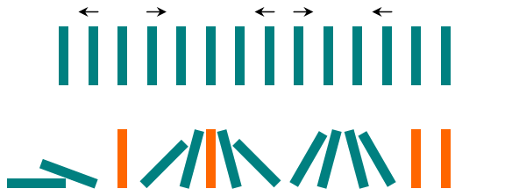CF405B.Domino Effect
普及/提高-
通过率:33.80%
AC君温馨提醒
该题目为【codeforces】题库的题目,您提交的代码将被提交至codeforces进行远程评测,并由ACGO抓取测评结果后进行展示。由于远程测评的测评机由其他平台提供,我们无法保证该服务的稳定性,若提交后无反应,请等待一段时间后再进行重试。
题目描述
Little Chris knows there's no fun in playing dominoes, he thinks it's too random and doesn't require skill. Instead, he decided to play with the dominoes and make a "domino show".
Chris arranges n dominoes in a line, placing each piece vertically upright. In the beginning, he simultaneously pushes some of the dominoes either to the left or to the right. However, somewhere between every two dominoes pushed in the same direction there is at least one domino pushed in the opposite direction.
After each second, each domino that is falling to the left pushes the adjacent domino on the left. Similarly, the dominoes falling to the right push their adjacent dominoes standing on the right. When a vertical domino has dominoes falling on it from both sides, it stays still due to the balance of the forces. The figure shows one possible example of the process.
 Given the initial directions Chris has pushed the dominoes, find the number of the dominoes left standing vertically at the end of the process!
Given the initial directions Chris has pushed the dominoes, find the number of the dominoes left standing vertically at the end of the process!
输入格式
The first line contains a single integer n ( 1<=n<=3000 ), the number of the dominoes in the line. The next line contains a character string s of length n . The i -th character of the string si is equal to
- "L", if the i -th domino has been pushed to the left;
- "R", if the i -th domino has been pushed to the right;
- ".", if the i -th domino has not been pushed.
It is guaranteed that if si=sj= "L" and i<j , then there exists such k that i<k<j and sk= "R"; if si=sj= "R" and i<j , then there exists such k that i<k<j and sk= "L".
输出格式
Output a single integer, the number of the dominoes that remain vertical at the end of the process.
输入输出样例
输入#1
14 .L.R...LR..L..
输出#1
4
输入#2
5 R....
输出#2
0
输入#3
1 .
输出#3
1
说明/提示
The first example case is shown on the figure. The four pieces that remain standing vertically are highlighted with orange.
In the second example case, all pieces fall down since the first piece topples all the other pieces.
In the last example case, a single piece has not been pushed in either direction.